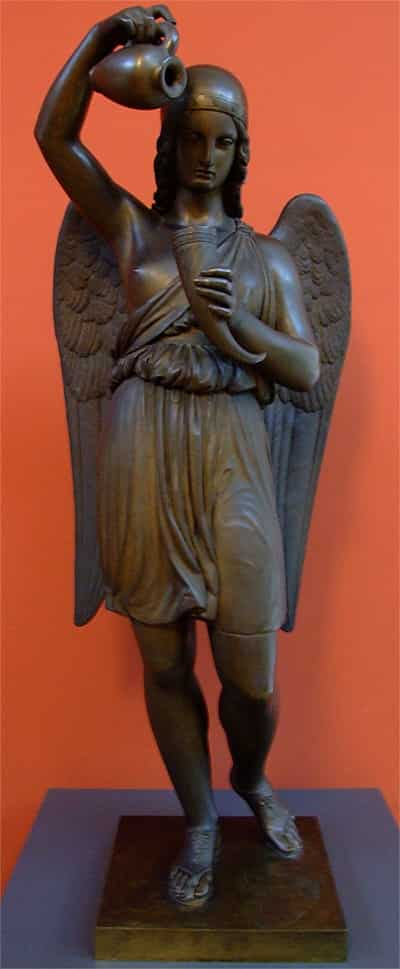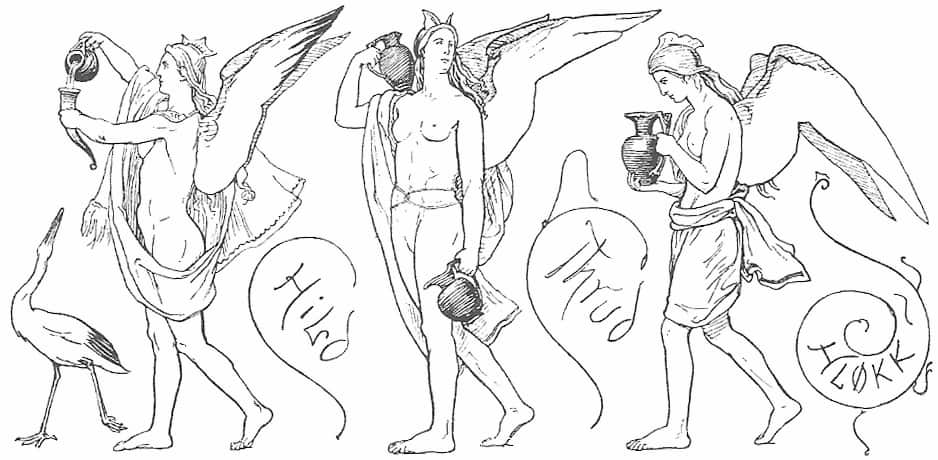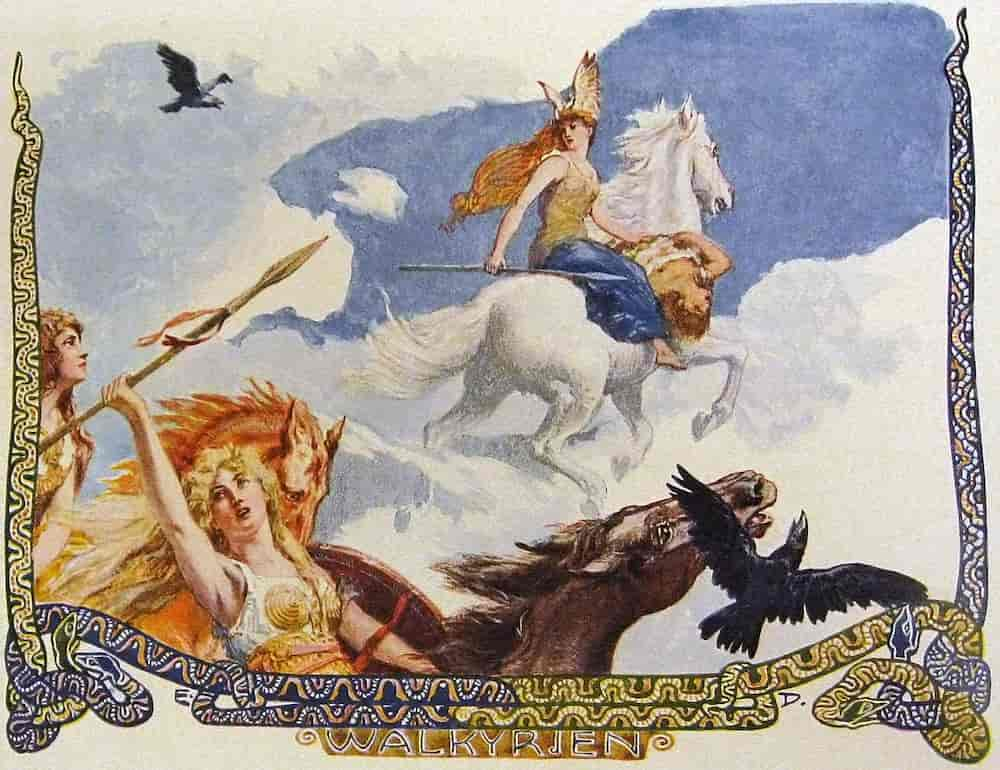Of the many Viking cultural elements now pervasive in modern society, Valkyries rank highly in popularity and adoption, especially amongst the ranks of those who put their lives on the line in battle.
From Wagner’s Ride of the Valkyries to the Marvel superhero named Valkyrie, the arbiters of battle have marched forward in time. And while there are plenty of Valkyrie Norse symbols in pop culture, as with many historical elements, it’s worth mentioning that pieces of their past have been steadily lost in translation.
That is, enjoy the modern interpretations for what they are, but there is plenty to learn about what Valkyries were supposed to be like – and plenty that historians are not sure on whether or not it’s entirely accurate.
Keep in mind that the body of knowledge about Norse mythology is largely derived from works published hundreds of years after the Viking Age, after Christianity arrived as the primary religion of the region. The distance in time and culture from the true source means the true details of Valkyrie symbols and meanings may never be known.
But that doesn’t make it interesting to learn about what is actually known today of what the Valkyrie symbolizes!

Table of Contents
What are Valkyries?
Valkyries are divine warrior women from Viking Age pagan beliefs. They had the first say in which Vikings were allowed into the preferred afterlife, and they were thought to influence the fate of battles.
The Valkyries’ primary duty was to serve Odin, leader of the Norse pantheon, by selecting warriors worthy of participating in Ragnarok, the final battle between the Aesir and their foes. Their service also included relatively mundane tasks like fetching horns of mead for Odin and the warriors in his residence, Valhalla.
To complete their duties, Valkyries are all capable of flight and various forms of combat with tools of their choosing. Some of them have further powers described, such as Hildr reviving the dead, but full details on all the Valkyries are unfortunately lacking.
Did Vikings worship Valkyries?
Vikings revered Valkyries to the point of making idols in their image and invoking their names in poetry. Given the importance of Valhalla to Norse paganism, a Viking would have done much to earn the attention of a Valkyrie.
From the numerous mentions in the earliest Viking mythology sources, like The Poetic Edda and The Prose Edda, it’s clear that Valkyries played a key role in the belief system. In 2013, archeologists discovered what they believe to be a statue of a Valkyrie, further showing how much Valkyries occupied the thoughts of Vikings.

It is possible that some Vikings would say prayers or make sacrifices to Valkyries as part of the same rituals they did to ask the gods for favors. Since the Valkyries worked directly for Odin, his importance in the pantheon would further elevate their importance. Without first-hand accounts of those practices, a definitive answer is elusive.
What is the Valkyrie symbol?
Valkyries are symbolically linked to battle, death, fate, judgment, horns, swans, flight, riding, ale, and warrior women. Each Valkyrie also has a name that is presumably linked to aspects of their powers, personality, or both. Although they are described as being able to fly, they are never explicitly described as having wings in their typical form.
On all sides saw I | Valkyries assemble,
Ready to ride | to the ranks of the gods;
Voluspa 31
Transformation is one of the more common powers in Norse mythology, and Hromund Gripsson’s saga describes a Valkyrie flying over the battlefield in the form of a swan.
Since they serve ale or mead in containers made from horns, both of these items have a symbolic connection to Valkyries. The other symbolic connections stem from their role of selecting dead warriors for Valhalla.

What is the Valkyrie symbol‘s origin?
Valkyries were a part of Norse pagan culture from long before the Viking Age. The concept of powerful warrior maidens with supernatural powers dates back to the Germanic tribes that eventually moved north and settled Scandinavia. Similarly, the connection to swans is linked to early pagan beliefs in the Germanic tribes.
For instance, The Three Swans is a German folktale that bears remarkable resemblance to Volundarkvitha, an entry within The Poetic Edda.
Both stories involve a trio of maidens who can transform into swans being caught while bathing outside of their magical garments. The details of the stories differ, but the parallels highlight how Germanic belief systems flowed into Norse paganism as time progressed.
Related: Did German Vikings Exist?
How many Valkyries are there?
The true number may never be known, but there are at least 24 when counting the Valkyries in the primary sources. Including the Valkyries from Nafnathular increases the count to 34.
Not every piece of the Eddas or other sagas made it through the centuries without suffering damage. Even before those manuscripts entrusted the stories to the future, the mythology of the Viking Age was fading fast. It’s entirely possible that many more Valkyries exist, but the above numbers are the baseline for now.
What are the names of the Norse Valkyries?
The list of Valkyrie names mentioned in the primary sources are:
- Hrist, whose name means “Shaker”.
- Mist, whose name conveniently means “Mist”.
- Skeggjold, whose name means “Axe Time”.
- Skogul, whose name means “Raging”.
- Hild, whose name means “Warrior”, though she is also the one likely referenced as Hildr (“Battle”), Sigdrifa (“Victory Giver”), and Brynhild (“Armored Warrior”).
- Thruth or Thrud, whose name means “Might”.
- Hlok, whose name means “Shrieking”.
- Herfjotur, whose name means “Host-Fetter”.
- Gol, whose name means “Screaming”.
- Geironul, whose name means “Spear-Bearer”.
- Randgrith, whose name means “Shield-Bearer”.
- Rathgrith, whose name means “Plan-Destroyer.”
- Reginleif, whose name means “Gods’ Kin”.
- Skuld, whose name is related to debts or the future.
- Skogul, whose name relates to shaking something, as with a loud projection.
- Geirskogul, whose name is the same as Skogul’s with “Spear” in front of it.
- Gondul, the “Wand-Wielder” or magic user.
- Gunnr, whose name is related to war.
- Sigrun, whose name means “Victory Rune” (which clearly hails directly to the Norse Runes).
- Rota, whose name is connected to storms and poor weather.
- Kara, whose name relates to storms and spinning.
- Olrun, whose name means “Ale-Rune”.
- Hlathguth the Swan-White.
- Hervor the All-Wise.
Note that you will likely see small variations in the written form of the names, especially those that incorporate more of the unique symbols that more closely match the original vocalizations of the language that Vikings spoke, compared to the anglicized versions.
Valkyries from Nafnapulur, an addition to the Prose Edda‘s Grimnismol, were also not included.
What is the Valkyrie symbol‘s meaning in Norse mythology?
A Valkyrie’s Norse symbol meaning was generally related to glorious death in battle to prove oneself worthy of journeying to Valhalla. Valkyrie symbols in Norse mythology thus promoted imagery of power, prestige and heroism, as also seen in the names of the Valkyries.
The importance of Valkyries can be seen in the number of Valkyries in specific stories. Three and its square, nine, are signifiers of prophecy and divinity in Norse mythology.
For example, three winters are supposed to come as the first warning sign of Ragnarok. In groups, Valkyries are often numbered with threes and nines, such as when “thrice nine” Valkyries ride in the Poetic Edda.

Why are Valkyries important in Norse mythology?
To a Viking warrior, a Valkyrie played a significant role in determining the end result of all their efforts in life. Based on her judgment, his soul would go to Valhalla, Folkvangr, or Niflheim. Only valiant warriors who died in battle were selected by the Valkyries, then Freya took half with her to Folkvangr.
That is, the Valkyries select the heroes that occupy Odin’s Valhalla and share Freya’s Folkvangr, two afterlife destinations in Norse mythology. Those not selected to go “until Valhalla” went to the misty abyss of Niflheim.
As the Norse pagan faith slowly incorporated Christian thematic elements through the long conversion, the Valkyries would have been seen as helpers in the rebirth of the world. The warriors selected by the Valkyries, and the Valkyries themselves, would be essential for the Twilight of the Gods.
Are Valkyries angels?
No, Valkyries are not angels. Valkyries have some shared thematic elements with angels, but they are not the same. While the Valkyries were all distinct individuals, they had the same general role and powers. Angels, however, tended to be ranked against one another.
The basic form of Valkyries was always that of adult women with physical prowess. There may have been a more expansive lore regarding the Valkyries, especially given the usage of specific Valkyrie names as colorful descriptions of various events like a battle or death in skald poetry.
In contrast, the angels of the Abrahamic religions have a vastly more complex ranking system with jobs delegated out between the tiers.

As these are living religions with more extensive documentation, it’s easier to see the full picture of these belief structures than those of Scandinavian pagans in the Viking age. Still, the organization of the Valkyries seems much more succinct as a small battalion of equals under Odin from the given sources.
The exact number of ranks and which jobs are assigned to each rank varies between the religions, but each one has about ten ranks of angels. Some were historically given great tasks like passing on knowledge to humans, sharing the word of God, or delivering punishment.
That God assigns a lower ranking angel to help and oversee each person is a common belief that’s not quite born out by all the scriptures, but the Valkyries wouldn’t care much about what happened outside of a battle.
Angels also have far more varied appearances, ranging from the common depiction of a human with wings to multi-headed chimeras that fly without moving. Valkyries could change into swans, but they were all adult women who wore clothing and armor that the Norse would have found familiar.
Are Valkyries good or evil?
While more neutral in tone overall, Valkyries would generally be considered to be good. A more accurate alignment assignment would be lawful neutral or lawful good. Overall, though, Valkyries were generally obedient to the rule of Odin and sought to fulfill their duty.
Valkyries were divine warrior maidens who served at the beck and call of Odin. While the alignment system of the Valkyries popularized by tabletop gaming has its flaws, they did tend to follow Odin’s instructions. There are exceptions that make them more dynamic, and stories that set other Valkyries apart may have been lost to time.
One clear example of such an exception is Brynhildr (Hildr, Hild, Sigdrifa) who was punished by Odin for disobedience.
On the mountain sleeps | a battle-maid,
And about her plays | the bane of the wood;
Ygg with the thorn | hath smitten her thus,
For she felled the fighter | he fain would save.
Fafnismol 43
Odin, named as Ygg here, did not have absolute control over the Valkyries in this example. That said, his authority over them could be enforced through his powers if he was pushed. Hildr’s punishment was not permanent, but the offense was not as great as the fallen angels like Satan.
More importantly, it shows that a simple definition of Valkyrie alignment is not easy. Brynhildr chose to kill a man without the backing of a body of law, an act which doesn’t quite fit with a “lawful good” alignment, but they certainly weren’t evil with respect to the overall mythos.
Related: 19 Most Famous Vikings in History (Who You Need to Know About)
What is the Shield Maiden Valkyrie symbol?
Valkyries are closely related to the concept of the shield maiden, though the two are not exactly the same. Without key identifying symbols, a depiction of a warrior woman from the Viking Age could be a shield-maiden or a Valkyrie.
Like angels, shield maidens have similar thematic elements to Valkyries that can make them easy to conflate with one another. A closer look at Norse mythology and culture reveals that the line is intentionally a bit blurry.
What’s the difference between Shield Maidens and Valkyries?
Shield maidens were mortal women who participated in combat, such as Lagertha, shield maiden and wife of Ragnar Lodbrok. Valkyries were a collection of beings that transcended mortal restrictions in the service of Odin, the leader of the primary Norse pantheon.
Valkyries were often disguised as shield-maidens or promoted from exceptional ones, blurring the lines between the two. Brynhildr is the worst offender, appearing multiple times in different variations throughout the mythos. Just remember that shield-maidens were real Viking women, while Valkyries are a product of old folklore.
While the extent of shield maidens in the ranks of the Vikings is difficult to determine, recently uncovered evidence points to at least some occurrences of warrior women within the raiding parties. If Valkyries were an inspiration to male Vikings, it would be reasonable to assume that they inspired female Scandinavians to join the Viking bands.

Why do people get tattoos of Valkyries?
Many of those who get a tattoo of a Valkyrie may be invoking them as a symbol of death in battle or eternal war in Valhalla. Others may simply like the common imagery of the Valkyries. As with the Vikings of old, modern people may look to the Valkyries for solace and motivation.
Of course, judging anyone’s choices on tattoos from afar is difficult. At the same time, it’s true that the Valkyrie Norse symbols have proven to be both reassuring and empowering throughout history, so there’s no reason that the same couldn’t be true now.
Much like other Viking tattoos that have remained popular, a tattoo of a Valkyrie symbol would serve as a consistent reminder of that belief without the need to carry a piece of jewelry, like a Valkyrie symbol necklace (which has also gained huge popularity on sites like Etsy in recent years) or another item akin to a rosary.
In some cases, there may be no meaning other than enjoying the way an image looks. A warrior woman riding a massive horse and wielding a spear is a powerful scene, while plenty of others have chosen to get a Valkyrie wings tattoo on their back due to either the power it invokes or just because it looks pretty amazing aesthetically.
Interpretations of Valkyrie symbolic elements, whether historically accurate or not, are split along the same lines as general Valkyrie tattoos. Some will assign significance to the tattoos, likely relating to death and courage. Others will think that the sword with wings coming out of the handle looks awesome. And there’s every chance that both are true!
